NOTRE solution n°3 : DAMAGE CONTROL
vos dents tombent avec une résorption de l'os maxillaire
le sauvetage de votre sourire en une seule intervention
une chirurgie en "one shot" SOUS ANESTHÉSIE GÉNÉRALE
LA SOLUTION SMILE DESIGNER N°3 : LE "DAMAGE CONTROL"
un sauvetage POUR LA RESTITUTION DE VOTRE SOURIRE EN DÉTRESSE
UNE CHIRURGIE DE POSE D'IMPLANTS EN UNE INTERVENTION "ONE SHOT"
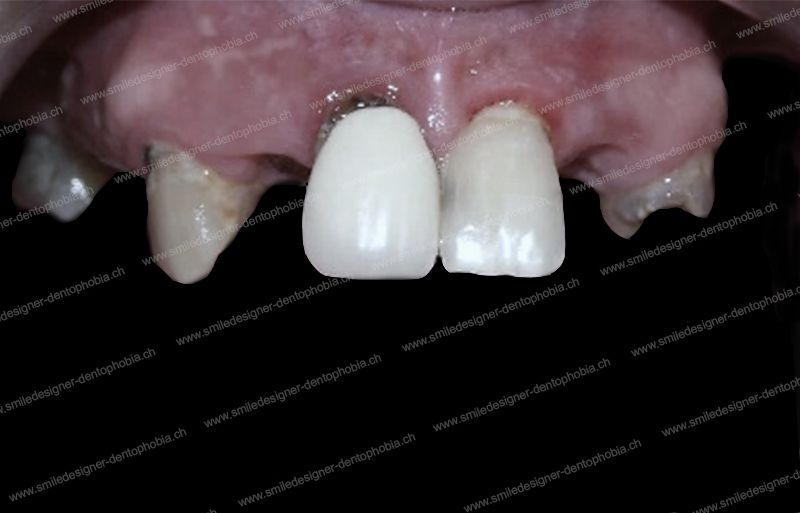
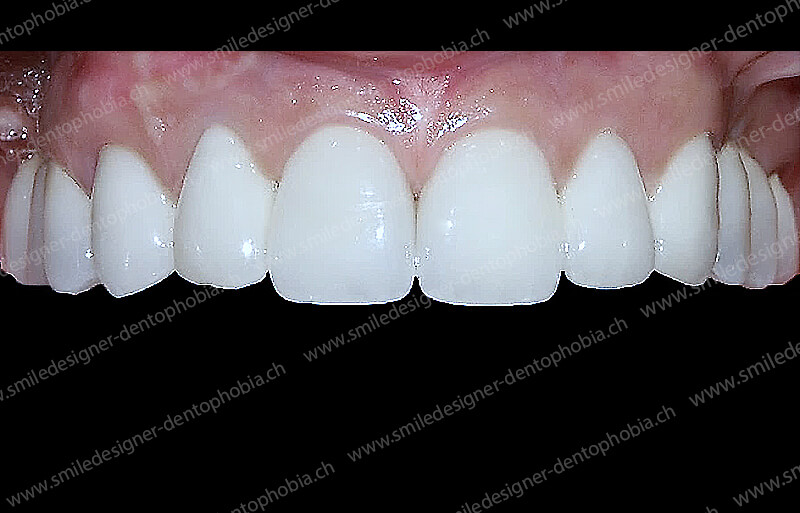


" LA GRANDEUR DE MA CIVILISATION, C'EST QUE CENT MINEURS S'Y DOIVENT DE RISQUER LEUR VIE POUR LE SAUVETAGE D'UN SEUL ENSEVELI. ILS SAUVENT L'HOMME "
ANTOINE DE SAINT-EXUPERY
NOTRE PROTOCOLE MCI DE SAUVETAGE DE VOTRE SOURIRE : LE "DAMAGE CONTROL"
DEUX BRIDGES IMPLANTO-PORTÉS "ALL ON 8/6 AVEC EXTENSIONS
UNE SOLUTION DE SAUVETAGE EN PLUSIEURS ÉTAPES POUR UN RESTITUTIO AD INTEGRUM
POUR RÉPONDRE AU SOS de LA PERTE DE VOTRE SOURIRE et le RISQUE DE DÉSOCIALISATION
Notre solution Numéro trois : Le « Damage Control MCI »
C’est un protocole de pose d’implants en mise en charge immédiate de sauvetage de votre sourire et de votre mastication postérieure, au plus rapide, sans greffe osseuse pré-implantaire et cela, même si la résorption osseuse alvéolaire est trés importante au niveau des secteurs des deuxièmes prémolaires et des molaires.
Ce protocole de sauvetage de votre sourire, grâce à la pose d’implants au plus rapide, est réalisé selon le schéma opératoire suivant :
– La pose de 8 implants, en remplacement des dents antérieures du maxillaire, de prémolaire droite à prémolaire gauche et de 6 implants à la mandibule.
– La pose quelque jours plus tard, grâce à une Mise en Charge Immédiate des implants dentaires, d’un bridge esthétique implanto-portée AVEC deux extensions aux extrémités postérieures, pour remplacer les prémolaires ou au mieux les premières molaires.
Dans un cas de chirurgie bi-maxillaire, le remplacement des dents antérieures et postérieures de la mandibule est réalisé grâce à une Mise en Charge Immédiate de 6 à 8 implants dentaires par deux bridges implanto-portés transvissés.
C’est en générale au maxillaire supérieur que les problème de résorption osseuse des régions postérieures sont les plus importantes.
Au maxillaire supérieure (mais aussi à la mandibule) la prothèses supra-implantaires en MCI est soutenue par les implants de prémolaire droite à prémolaire gauche AVEC deux extensions postérieures au niveau des prémolaires ou des molaires.
L’ajout des extensions molaires aux extrémités du bridge permet un calage molaire à minima, même si ces dents ne sont pas soutenues par des piliers implantaires.
C’est la forme « la plus minimaliste et de sauvetage d’extreme justesse » de nos protocoles de sauvetage de votre sourire et de votre mastication postérieure, sans avoir à pratiquer des greffes osseuses pré-implantaires, en cas de gros délabrement de votre denture et de votre sourire et avec une forte résorption osseuse alvéolaire.
Nous appelons notre solution chez Smile Designer le « Damage Control MCI ».
– « Damage Control » : parce que notre protocole va permettre de contrôler les dommages que vos dents et votre sourire ont subi, trés rapidement en une intervention one shot.
Cette version de MCI nécessite deux extensions postérieures prémolaires et/ou molaires au bridge implanto-porté pour compléter l’arcade dentaire, elle permet une dispersion optimum des forces de mastication grâce à la pose d’un nombre maximum d’implants, compte tenu de l’os disponible et malgré la résorption osseuse.
Notre protocole « Damage Control MCI » permet une parfaite reconstruction de vos arcades dentaires, même dans l’urgence d’une désocialisation rapide, conséquence de la perte inéluctable de vos dents, associée à une grosse résorption osseuse postérieures des maxillaires, en particulier le supérieur.
Dans la technique « Damage Control MCI », nous arrivons, malgré la résorption osseuse postérieure maxillaire (en particulier supérieure) à poser 8 implants au maxillaire supérieur.
C’est-à-dire 4 implants symétriques de chaque côté de la ligne sagittale médiane : ALL on 8.
La particularité de cette technique est que : le bridge implanto-porté, en mise en charge immédiate sur les implants posés, supporte une dernière prémolaire ou une première molaire en extension, de chaque côté et à ses extrémités postérieures
Les cas clinique qui permettent l’indication du « Damage Control » en MCI sont à la frontière des cas favorables et défavorables :
La situation du volume osseux disponible implantable doit permettre de poser huit implants au maxillaire (quatre implants à gauche et quatre à droite) au lieu de six implants seulement dans les cas cliniques défavorables qui posent l’indication de la solution de secours « Domino Surgeries ».
Les indications du « Damage Control » sont les suivantes :
– Des dimensions du volume osseux des maxillaires disponibles nécessaires et suffisantes pour une pose d’implants en All on 8/6 ;
– Associées à une résorption modérée de l’os alvéolaire antérieur jusqu’aux régions des premières prémolaires ;
– Une résorption des régions prémolaires et molaires interdisant une solution « Gold Damage Control » et bien sur « Gold Standard ».
En conséquence, il y a toujours une dent terminale postérieure en extension : la dernière prémolaire ou première molaire.
La configuration de notre « Damage Control » est une variante de sauvetage dans situation d’édentement à l’extrême limite du confort de mastication, dans des cas cliniques défavorables interdisant la solution du « Gold Damage Control MCI ».
Elle peut être soit une une solution définitive si les première molaires sont remplacées et si le patient est d’un gabarit raisonnable.
Ou bien, elle peut être une solution d’attente confortable avant de tenter de se rapprocher de notre « Gold Standard MCI » grâce à une série de greffes pré-implantaires.
La solution du « Damage Control » MCI permet non seulement une reconstruction immédiate de toute l’arcade, mais également un calage à minima mais optimisé de la morsure que l’on appelle « l’occlusion molaire ».
L’occlusion molaire permet de bloquer la morsure en position articulaire reculée (relation centrée) et protéger l’articulation temporo-mandibulaire ou ATM.
Cette version est une solution de sauvetage immédiat de votre sourire et de votre mastication grâce à notre protocole « Damage Control MCI ».
Cette technique permet le remplacement des dents antérieures du maxillaire :
Grâce à une Mise en Charge Immédiate de 8 implants dentaires, par un bridge esthétique implanto-porté soutenu de prémolaire droite à prémolaire gauche, avec des extensions postérieures remplaçant :
- Les deuxièmes prémolaires au pire ;
- Les premières molaires au mieux.
Dans le cas d’une MCI mandibulaire :
Le remplacement de toutes les dents du maxillaire inférieur par des implants est réalisé grâce à la pose de 6 implants dentaires.
Leur Mise en Charge Immédiate est effectuée par une prothèse implanto-portée soutenue de prémolaire droite à prémolaire gauche, avec deux extensions postérieures molaires.
L’ajout des extensions molaires aux extrémités du bridge permet un calage molaire même si ces dents ne sont pas soutenues par des piliers implantaires.
- Le plus gros avantage de notre solution est une reconstruction globale immédiate et quasiment à l’identique des arcades dentaires lors d’une situation désespérée qui nécessite l’extraction rapide de la totalité des dents résiduelles, sans avoir à pratiquer des greffes osseuses pré-implantaires de reconstruction des maxillaires et cela, même si la résorption osseuse postérieure est très importante.
- Le chirurgien et le patient s’exonèrent de pratiquer des chirurgies pré-implantaires complexes, comme des comblements de sinus (sinus lift).
- Le coût reste modéré, par rapport à un bridge céramique complet implanto-porté en mise en charge immédiate qui nécessiterait des greffes osseuses et/ou des comblements de sinus (sinus lift).
- Les inconvénients mécaniques et les risques de fractures de pièces métalliques implantaires (ex: vis, implants, armatures) dans la version historique des All on 6/4, liés au relativement faible nombre d’implants dentaires (quatre à la mandibule et six au maxillaire) qui supportent un grand nombre de dents prothétiques, n’existent plus.
- Le problème de la version historique « All on 6/4 » avec un bridge porté par des implants dentaires concentrés dans la zone antérieure des maxillaires, supérieure et inférieur, créant un porte-à-faux dû à la bascule antéro-postérieure, n’existe plus.
- Il restaure une belle esthétique au niveau des dents du sourire, pour des patients exigeants, exactement comme un bridge total implanto-porté de molaire à molaire.
- Sa grande résistance mécanique fait qu’il convient à la moyenne des gabarits : des personnes âgées aux personnes actives et pour tous les types d’alimentation.
- Si le chirurgien et le patient s’exonérent de pratiquer des chirurgies pré-implantaires complexes, comme des comblements de sinus (sinus lift), les extensions prémolaires restaurent, malgré tout une fonction masticatrice minimale et dans une moindre mesure le calage articulaire des ATM.
- La calage molaire au niveau des extensions postérieures du bridge, même à minima, permet de protéger les articulations temporo-mandibulaires et d’éviter différentes pathologies comme des douleurs articulaires, des vertiges, des acouphènes etc.
- L’inconvénient majeur est d’avoir une arcade prothétique moins étendue en postérieur, dans les régions prémolaires et molaires masticatrices : la charge occlusale est ainsi déportée vers les dents de devant. Mais dans cette version modernisée et renforcée du protocole historique All on 6/4 cela ne pose pas de problème de résistance mécanique.
- Ce protocole ne convient pas pour de fort gabarit car il y a un risque accrue de fracture du bridge implanto-porté et/ou des implants.
- Même si le chirurgien et le patient s’exonérent de pratiquer des chirurgies pré-implantaires complexes en prérequis de la pose des implants, c’est en général reculer pour mieux sauter car elles sont souvent indispensables pour étendre l’occlusion molaire en postérieur. C’est le principe des chirurgies en cascades qui sont décrites dans notre protocole « DOMINO SURGERIES MCI ».
- Même si les extensions prémolaires restaurent une fonction masticatrice minimale elle est le plus souvent insuffisante et le calage articulaire des ATM est inefficace. Le protocole est accompli que lorsque les premières molaires sont remplacées par deux extensions postérieures du bridge. En deça de cette limite des chirurgies en cascades décrites dans notre protocole « DOMINO SURGERIES MCI » seront nécessaire pour arriver à cet objectif.
- Si le calage molaire est inexistant, des pathologies des articulations temporo-mandibulaires (ATM) peuvent survenir à moyen ou long terme. Par exemple, des douleurs ou craquements et/ou une mobilité des ménisques inter-articulaires peuvent être ressentie et/ou des acouphènes.

Notre résultat clinique : vous disposez de votre tout nouveau sourire en une seule intervention de pose d’implant avec la délivrance de vos bridges implants-portés en seulement quelques jours.
Le « Damage Control MCI »: Notre protocole de pose d’implants de prémolaire à prémolaire ou “All on 8” au maxillaire et “All on 8/6” à la mandibule et la réalisation de deux bridges complets implanto-portés de prémolaire à prémolaire, avec des extensions pour remplacer les deuxièmes prémolaires ou les premières molaires.
VOUS ÊTES UNIQUE !
CAS CLINIQUES DE RECONSTRUCTION DU SOURIRE AVEC
NOTRE SOLUTION 3 "DAMAGE CONTROL" EN MCI
SMILE DESIGNER & DENTOPHOBIA PRÉSENTE SON PROTOCOLE MCI DE SAUVETAGE
DES CAS D'ÉDENTEMENT AVEC FORTE RéSORPTION OSSEUSE
ET LA RECONTRUCTION EN URGENCE DE VOTRE SOURIRE
LE "DAMAGE CONTROL MCI": ALL ON 8/6
QUELS SONT LES INGRÉDIENTS PRINCIPAUX DU PROTOCOLE IMPLANTAIRE "DAMAGE CONTROL MCI"?
Voici la recette de notre protocole « Damage Control MCI » : Notre meilleure solution de réparation quasi « ad integrum » (retour à l’état normal après le dommage) des personnes en souffrance d’une réhabilitation totale de leur sourire. Une solution trés rapide et sans greffe osseuse pré-implantaire pour le sauvetage des personnes dans la souffrance d’un édentement et une réhabilitation urgente quasi totale de leur sourire.
Il convient même pour les cas de forte résorption osseuse molaire et prémolaire. Mais à condition de pouvoir implanter dans les régions des premières prémolaires au minimum.
Une Mise en Charge Immédiate de 8 implants au maxillaire et de 6 implants à la mandibule par un bridge complet MCI AVEC deux extensions de prémolaire à prémolaire ou de molaire à molaire dans le cas le plus favorable. MAIS avec un appui postérieur prémolaire terminal optimisé, pour soutenir le bridge implants-porté et répartir les charges de mastication avec un minimum de porte à faux pour un gain de forces de mastication molaires maximum.
- LA POSE DE 8 IMPLANTS DENTAIRES MAXIMUM PAR ARCADE, EN REMPLACEMENT DÉFINITIF DES DENTS DU SOURIRE ÉLARGIES AUX PRÉMOLAIRES/MOLAIRES, OU BIEN DANS URGENCE DU SAUVETAGE ET EN ATTENTE D’UNE RECONSTRUCTION GLOBALE DÉFINITIVE PLUS ÉTENDUE.
- POSER UN NOMBRE MAXIMUM D’IMPLANTS ANTÉRIEURS POUR RECRÉER LE FESTONNAGE GINGIVALE DU SOURIRE
- APPORTER UNE TRAME COLLAGÉNIQUE GRÂCE AUX GREFFES OSSEUSES ALLOGÈNES ET XÉNOGÈNES.
- APPORTER DES FACTEURS DE CROISSANCES TISSULAIRES CONTENUS DANS LES PLATELET-RICH FIBRIN AUTOLOGUES.
- POSER, QUELQUE JOURS APRÉS L’INTERVENTION, LE BRIDE RÉSILIENT MCI AVEC UN HABILLAGE COSMÉTIQUE EN COMPOSITE
- L’USINAGE CFAO EST FAITE À PARTIR D’UNE RECHERCHE OPTIMISÉ PAR L’ÉTUDE « SMILE DESIGN » ET LES TECHNOLOGIES NUMÉRIQUES CFAO.
- LE BRIDGE « DAMAGE CONTROL » DÉFINITIF EST POSÉ 6 À 12 MOIS PLUS TARD AVEC UN HABILLAGE COSMÉTIQUE EN CÉRAMIQUE (qui remplace le bridge résilient, avec un habillage cosmétique en résine due type matériaux hybrides composites, transitoire durant la phase cicatricielle.
LE FILM D'UNE CHIRURGIE “ALL ON 8” & “ALL ON 6”
LE "DAMAGE CONTROL MCI":
LA Reconstruction de tout uN sourire avec deux bridges haut et bas sur implants EN mise en charge immédiate.
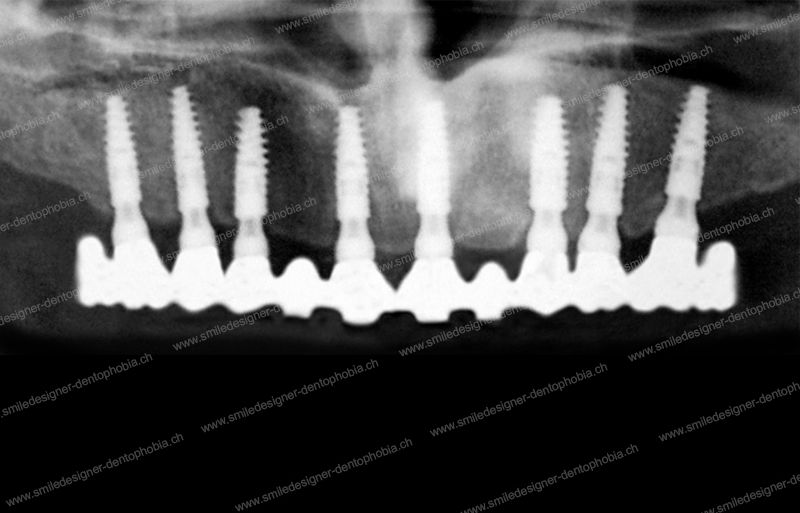
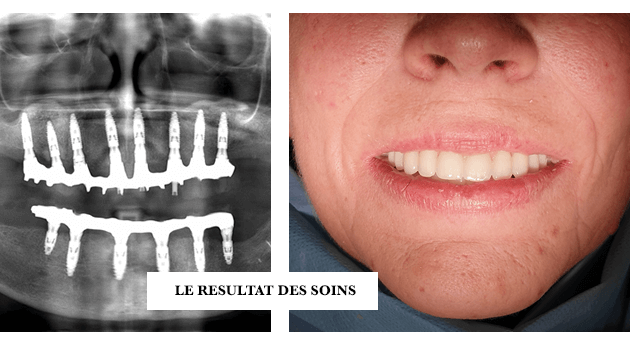
LE FILM D'UNE INTERVENTION DE COMBLeMENT DE SINUS OU"SINUS LIFT" AVEC L'APPORT DE LA DENTISTERIE RÉGÉNÉRATIVE : LE "PRF"
La chirurgie du "sinus lift".
le prérequis à la pose des implants en Mise en Charge immédiate
SOUS ANESTHÉSIE GÉNÉRALE
LE « DAMAGE CONTROL MCI »
Pourquoi appelons-nous cette technique de pose d’implants dentaires le « Damage Control MCI“?
Le terme de « Damage control », donné à cette solution d’implantologie en mise en charge immédiate, est issu du jargon de la US Navy, qui décrit l’aptitude d’un navire fortement endommagé à gagner un haut-fond pour s’y échouer et ensuite être remis à flot après réparation.
Ce terme présente les éléments essentiels du nouveau concept de Smile Designer & Dentophobia appliqués à la chirurgie implantaire en MCI.
Il est très fréquent que des personnes soit dans une situation dentaire catastrophique parce que leurs dents sont soit d’ores et déjà perdues, soit condamnées à très court terme.
Or, cette situation dramatique a, dans les protocoles d’implantologie classiques, peu de solution de réparation immédiate. En effet, le plus souvent les chirurgiens extraient les dents et éventuellement les remplacent par des implants. La pose d’implants n’est pas classiquement immédiate mais le plus souvent quatre à cinq mois plus tard, après la cicatrisation osseuse post extractionnelle.
Très peu de protocole permettent de remplacer toutes les dents du sourire par une prothèse esthétique en moins d’une semaine, avec une seule intervention chirurgicale, comme dans notre technique en « one shot » : « Damage Control MCI »,
Encore moins de protocole permettent de restaurer immédiatement la fonction de mastication des prémolaires, voir même des molaires dans certains cas cliniques favorables.
Grâce à notre protocole « Damage Control MCI », nous arrivons à non seulement remplacer toutes les dents du sourire, mais également, à restaurer la fonction de mastication jusqu’au niveau des prémolaires, voir même des molaires.
Nous mettons moins d’une semaine, pour réaliser ce protocole de pose d’implants en mise en charge immédiate.
Même si la situation de résorption osseuse post extractionnelle dans les secteurs postérieurs des deuxièmes prémolaires et des molaires et a créé une atrophie osseuse telle qu’il est impossible de mettre des implants dans ces zones, grâce à notre technique de bridge implanto-porté avec des extensions postérieures prémolaires ou molaires, nous arrivons à sauver la situation occlusale et stabiliser le patient sur tous les plans fonctionnels et esthétiques.
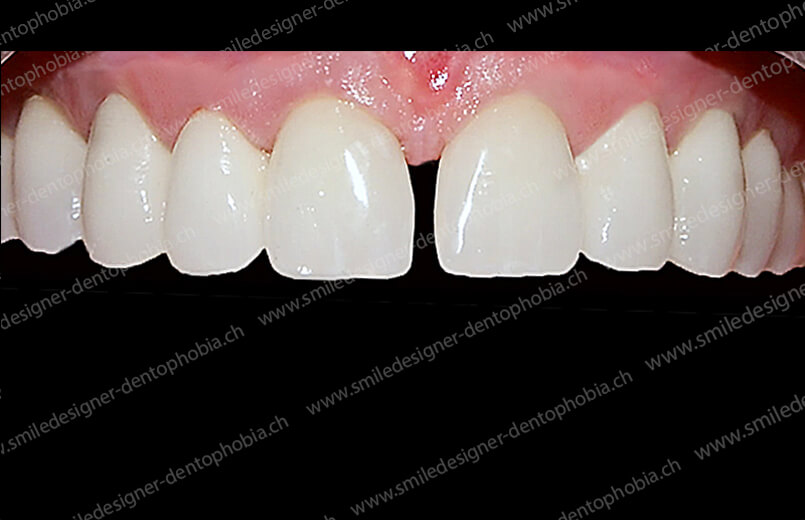
Notre résultat : votre tout nouveau sourire en une seule intervention de pose d’implants et la délivrance des deux bridges implanto-portés résilient avec un cosmétique de type matériaux hybrides ou composites, en Mise en Charge et esthétique Immédiate, quelques jours plus tard.
Dans ces images de résultat clinique : le résultat après six à douze mois de cicatrisation. Les bridges résilients avec un cosmétique en composite sont remplacés par des bridges définitifs implanto-portés, avec un cosmétique en céramique. (Ici sur la photo)
Ils sont transvissés ou scellés, sur les implants dentaires sur toute la longueur de la mâchoire, de prémolaire à prémolaire ou de molaire à molaire, AVEC des portes à faux postérieurs.
Voir le détail du protocole et des cas cliniques dans les chapitres correspondants.
Avertissement : Même si nous affichons des résultats cliniques satisfaisants sur nos photos de présentation, ils ne peuvent en aucun cas être des promesses de succès similaires concernant votre propre situation clinique. Chaque personne est différente et les cas cliniques uniques.
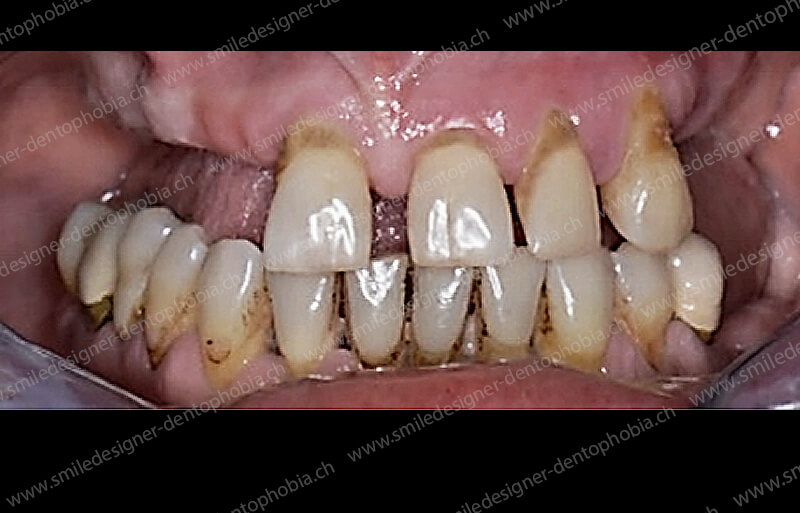

Notre résultat : votre tout nouveau sourire en une seule intervention de pose d’implants et la délivrance des deux bridges implanto-portés résilient avec un cosmétique en composite, en Mise en Charge et esthétique Immédiate, quelques jours plus tard.
Voir le détail du protocole et des cas cliniques dans les chapitres correspondants.
Avertissement : Même si nous affichons des résultats cliniques satisfaisants sur nos photos de présentation, ils ne peuvent en aucun cas être des promesses de succès similaires concernant votre propre situation clinique. Chaque personne est différente et les cas cliniques uniques.
Une technique qui permet de stabiliser le patient socialement et émotionnellement dans les cas d’édentement grave et lorsque le volume osseux implantable est quasiment ou totalement indisponible dans les secteurs postérieurs.
Dans des cas de parodontite terminale (déchaussement des dents) ou bien de kystes péri-apicaux étendus (kystes endodontiques aux bouts des racines dentaires), il est fréquent que le volume osseux soit totalement atrophié.
Dans ces situation critiques il n’est plus possible de poser des implants dentaires pour remplacer les dents postérieures prémolaires et/ou molaires.
Des greffes pré-implantaires doivent être réalisées pour reconstruire ce volume osseux perdu.
C’est technique sont connues et bien cataloguées. Il n’y a aucun problème à les mettre en oeuvre. Toutes ces technique sont décrites dans notre solution numéro 4 : « Domino Surgeries MCI ».
Mais cela prend du temps !…
Il faut consacrer du temps opératoire et lui additionner le temps de cicatrisation. C’est à dire quatre mois de cicatrisation osseuses plus quatre mois d’ostéointégration des implants. Dans certain cas favorable ces deux temps de cicatrisation sont confondus.
Si, le patient est dans une situation clinique qui ne met pas en péril ses dents antérieures, il n’y a pas de problème à prendre son temps pour réaliser ces cascades d’interventions de chirurgies préimplantaires afin de reconstruire les secteurs postérieurs.
Ces techniques de « Sinus lift », par exemple, sont décrites dans notre chapitre sur l’implantologie conventionnelle en « one shot », sous anesthésie générale.
Mais la situation est totalement différente lorsque l’indication d’une extraction avec implantation en mise en charge immédiate est posée, puisque par définition la situation clinique du patient est un péril qui peut être quasi immédiat.
Par nature, cette situation clinique implique que le secteur antérieur soit condamné tout autant que les secteurs postérieurs.
Les cas de figures cliniques les plus favorables à une pose d’implants en Mise en Charge Immédiates sont traités dans les deux précédents protocoles à savoir la solution 1 « Gold Standard MCI » et la solution 2 « Gold Damage Control MCI ».
Mais, il y a des situations encore plus graves, où le patient est dans une situation critique telle que ses dents antérieures tout autant que postérieures sont toutes en train « de tomber », dans un avenir quasi immédiat, le projetant dans une situation personnelle et professionnelle catastrophique.
Et si, comble de malchance, la résorption osseuse postérieure est trés avancée, la pose des implants devient critique!
Il y a aussi certaines situations où les dents sont d’ores et déjà perdues.
Ces personnes, en particulier stomatophobiques, si elles sont en panne de solution peuvent se retrouver en errance médicale pendant une longue période où la souffrance psychologique de la disgrâce s’ajoute à la souffrance physique de la mutilation.
Ces circonstances dramatiques entraînent une succession de « perte de chances » à la fois professionnelles, sociales, affectives, familiales qui non seulement concernent la période noire correspondant à la perte de son aspect esthétique, mais également son futur.
Car tout ce qui n’a pas été fait et tout ce qui n’aura pas pu être fait, à la suite de la disgrâce due à la perte des dents, entraînera des conséquences funestes quelques fois pendant plusieurs années, voir toute sa vie.
Dans certains cas les plus tragiques, cela déterminera une faillite personnelle et/ou professionnelle du patient qui n’aura pas pu suivre un enseignement, ou une carrière professionnelle, ou un mariage. Les conséquences mortifères sont aussi infinies que désastreuses.
Nous avons donc imaginé un protocole qui puisse résoudre immédiatement la plupart des problèmes de ces personnes en situation de péril, sans fermer aucune porte thérapeutique, nécessaire pour optimiser la situation clinique dans le futur.
C’est notre solution 3 : « Damage Control MCI ».
Cette solution vient au secours des deux premières:
La solution 1 : « Gold Standard MCI » peut être pratiquée lorsque la résorption osseuse est trés faible et que tous les implants peuvent être posés de prime abord ou que des chirurgies de greffes pré-implantaires puissent être faites au préalable, sans urgence ni stress.
La solution 2 : « Gold Damage Control MCI » peut être pratiquée lorsque la résorption osseuse est moyenne et que presque tous les implants peuvent être posés de prime abord pour restaurer les secteurs postérieurs ad integrum.
L’astuce des extensions postérieures molaires permet de s’exonérer de faire des chirurgies de greffes pré-implantaires.
La solution 3 : « Damage Control MCI » est pratiquée lorsque les deux autres solutions ne sont pas possible car la résorption osseuse est forte ou trés forte. Tous les implants ne peuvent pas être posés de prime abord et des chirurgies de greffes pré-implantaire ne peuvent pas être faites au préalable.
L’urgence et la gestion du stress commande de restaurer l’intégrité physique du patient.
A la suite de la conduite de notre protocole numéro 3 Damage Control MCI, nous allons nous trouver dans deux cas de figure :
Dans le premier cas de figure, le plus favorable, le Damage Control MCI a rempli complètement ses missions de sauvetage du patient et de quasi restitutio ad integrum de l’arcade dentaire :
Comme notre protocole est une thérapeutique extrêmement puissante, nous arrivons, en général, à mettre suffisamment d’implants dans le secteur antérieur et les deux secteurs latéraux pour restaurer complètement l’arcade dentaire. À condition de créer deux extensions postérieures aux extrémités postérieures du bridge implanto-portée en mise en charge immédiate, pour remplacer les premières molaires.
Dans ce cas la solution numéro trois, Damage Control MCI, a rempli sa mission de sauvetage et le patient peut choisir de rester dans cette situation puisqu’il va avoir 12 dents nécessaires et suffisantes de première molaire droite à premiere molaire gauche.
Il a reconstruit les secteurs postérieurs des arcades dentaires, même partiellement, la fonction masticatrice et l’esthétique du sourire.
Dans le deuxième cas de figure, le Damage Control MCI a rempli complètement sa première mission de sauvetage du patient mais partiellement celle de la reconstruction de l’arcade dentaire :
Comme notre protocole est une thérapeutique extrêmement puissante, il a restauré immédiatement les personnes en errance médicale. En effet, nous arrivons a mettre suffisamment d’implants dans le secteur antérieur pour reconstruire l’esthétique des dents du sourire afin d’éviter une désocialisation du patient.
Mais dans le cas de figure où les deux secteurs latéraux ont une crête osseuse alvéolaire très résorbée, il est impossible de poser des implants dans ses zones postérieur et donc de restaurer complètement l’arcade dentaire.
Il est possible de créer deux extensions postérieures aux extrémités postérieures du bridge implanto-portée en mise en charge immédiate, pour remplacer les prémolaires.
Mais comme nous l’avons vu plus haut ce calage prémolaire et molaire est insuffisant pour une mastication efficace et une bonne santé des articulations temporo-mandibulaires.
L’intérêt de notre solution numéro quatre « DOMINO SURGERIES MCI » :
Une fois ce premier sauvetage réalisé grâce au Damage Control MCI, nous arrivons au fils du temps à reconstruire les secteurs postérieurs pour ajouter des implants dans ces zones et augmenter la reconstruction des maxillaires jusqu’à un résultat « ad integrum » de type « Gold Standard MCI » ou « Gold Damage Control MCI ».
C’est-à-dire une reconstruction complète de toutes les arcades dentaires, de la fonction masticatrice, et de l’esthétique du sourire.`
Ces protocoles de reconstruction des arcades dentaires seront décrits dans le chapitre correspondant « DOMINO SURGERIES MCI »
Notre solution « Damage Control MCI » : le protocole de sauvetage définitif de votre sourire
Voici le dilemme auquel nous avons été confronté :
Comment gérer la détresse de personnes présentant des dents tellement malades qu’il est urgent de les extraire mais sans édenter ni désocialiser le patient ?
– Il est fréquent que des personnes présentent des dents quasiment détruites à cause d’une pathologie carieuse grave (polycarie).
En conséquence, leur denture est tellement délabrée que l’indication d’extraction et d’implantation globale, en URGENCE, est posée.
– Nous rencontrons fréquemment des patients ayant une parodontopathie terminale. C’est-à-dire un déchaussement des dents tel que toutes les dents sont susceptibles de tomber à n’importe quel moment. Dans ce cas également, leur denture est tellement délabrée que l’indication d’extraction et d’implantation globale, en URGENCE, est posée.
– Il n’est pas rare non plus que des patients d’ores et déjà soignés présentent des prothèses dentaires sur des dents naturelles ou des implants en fin de vie, comme des couronnes ou des bridges brisées à la suite d’infections dentaires. Dans ce cas également les dents piliers de ces prothèses sont à extraire. Ici aussi, leur denture est tellement délabrée que l’indication d’extraction et d’implantation globale, en URGENCE, est posée.
Dans tous les cas de figure précédemment cités, la personne se trouve dans une situation désespérée, car si ses dents sont toutes ou même partiellement perdues, elle ne peut plus ni manger correctement, ni sourire. De plus, elle aura certainement des problèmes dans son travail et dans sa vie relationnelle familiale et/ou affective.
Cette situation d’édentement inéluctable à brève échéance entraîne, d’une part, des problèmes de santé à cause des infections dentaires qui sont en général la source du problème et qu’il faut donc résoudre rapidement par une intervention chirurgicale curative.
Et d’autre part, la désocialisation brutale qui en résulte pose d’autres problèmes, entraînant éventuellement une décompensation psychologique, voir un risque que cette personne tombe en dépression ou même perde son travail et ses revenus.
Cette technique nécessite un volume osseux suffisant pour poser des implants jusqu’aux régions des prémolaires. Mais nous avons la possibilité de reconstruire les régions osseuses atrophiées par des greffes osseuses si nécessaire.
Si le volume osseux est suffisant, nous cherchons à aller jusqu’aux régions des deuxièmes prémolaires. Nous cherchons à être au plus près de la cavité sinusienne au maxillaire.
En général, grâce au mini implants, nous débordons en bas à la mandibule, au-delà de la région de la sortie du nerf alvéolaire inférieur, afin d’être le plus postérieur possible. Grâce à ce nombre d’implants augmenté, nous pouvons créer sur le bridge implanto-porté deux extensions molaires qui restaurent en grande partie la fonction occlusale et masticatrice molaire.
Dans ces conditions, cette version modernisée et optimisée du ‘All on” grâce à la pose d’un maximum d’implants permet la réalisation d’un bridge de 12 dents au maxillaire ainsi qu’à la mandibule pour un nombre d’implants de respectivement 8 et 8 ou 6.

Notre résultat : votre tout nouveau sourire en une seule intervention de pose d’implants et la délivrance des deux bridges implanto-portés résilient avec un cosmétique en composite, en Mise en Charge et esthétique Immédiate, quelques jours plus tard.
Voir le détail du protocole et des cas cliniques dans les chapitres correspondants.
Avertissement : Même si nous affichons des résultats cliniques satisfaisants sur nos photos de présentation, ils ne peuvent en aucun cas être des promesses de succès similaires concernant votre propre situation clinique. Chaque personne est différente et les cas cliniques uniques.
Notre résultat : votre tout nouveau sourire en une seule intervention de pose d’implants et la délivrance des deux bridges implanto-portés résilient avec un cosmétique en composite, en Mise en Charge et esthétique Immédiate, quelques jours plus tard.
Voir le détail du protocole et des cas cliniques dans les chapitres correspondants.
Avertissement : Même si nous affichons des résultats cliniques satisfaisants sur nos photos de présentation, ils ne peuvent en aucun cas être des promesses de succès similaires concernant votre propre situation clinique. Chaque personne est différente et les cas cliniques uniques.
Pour résoudre le précédent dilemme, les implantologues de smile designer ont structuré un protocole de sauvetage : le « Damage Control MCI »
Lorsqu’un patient nous adresse un SOS : nous pouvons extraire et réimplanter immédiatement toutes ses dents antérieures et le plus souvent tout ou partie des dents postérieures.
Le remplacement, même partiel des dents, essentiellement concentré sur les dents antérieures permet de ne pas désocialiser le patient. Nous traitons aussi toutes ses pathologies infectieuses en une seule chirurgie implantaire, dite en « one shot », sous anesthésie générale dans nos blocs opératoires en clinique.
Notre protocole est une adaptation moderne de chirurgie implantaire en Mise en Charge Immédiate du protocole historique “All on 6” et “All on 4”.
Nous essayons de poser 8 implants de prémolaire à prémolaire au maxillaire et 6 à 8 implants de prémolaire à prémolaire à la mandibule, mais avec deux extensions molaires en porte à faux, aux extrémités du bridge implanto-porté.
Cette technique est extrêmement puissante en terme de tentative de restitutio ad integrum, surtout au maxillaire supérieur, dans les cas d’atrophie des secteurs postérieures, suite à des extractions anciennes ou des kystes entrainant des résorptions osseuses.
Dans certains cas favorable si nous arrivons à mettre suffisamment d’implants, c’est-à-dire poser un Bridge implanto-porté sur huit implants au maxillaire supérieur et six implants au maxillaire inférieur, le plus souvent il n’est pas nécessaire de procéder à une reconstruction des secteurs postérieurs, car le bridge de prémolaire à prémolaire avec des extensions postérieures qui remplacent, soit les deuxièmes prémolaires, soit les premières molaires, suffisent largement à restructurer l’esthétique, récupérer la fonction masticatrice et éviter toute forme de désocialisation.
La meilleure situation clinique du Damage Control : Le bridge en MCI implanto-porté supérieur comporte donc 12 dents pour 8 implants au maxillaire. Et, le bridge en MCI implanto-porté inférieur comporte 12 dents pour 6 implants à la mandibule.
La situation clinique défavorable du Damage Control : L’atrophie osseuse postérieure des maxillaires est tellement étendue qu’elle ne permet pas de mettre des implants pour restructurer complètement l’arcade dentaire de première prémolaire droite à première prémolaire gauche, mais uniquement de canine à canine.
Pour autant, le sourire et la fonction masticatrice de base sont sauvés, immédiatement.
Dans les mois qui suivent la première intervention, nous traitons, au fils du temps, les pathologies et anomalies osseuses postérieures afin de reconstruire cette partie des maxillaires.
Cette situation clinique défavorable est assez fréquente. En particulier, au maxillaire supérieur à la suite d’extractions dentaires anciennes ou des infections radiculaires importantes qui ont entraînées une très grande pneumatisation des sinus, avec pour conséquence une résorption importante de l’os alvéolaire dans les secteurs postérieurs. Dans ce cas, ces régions nécessitent d’être reconstruites par des greffes osseuses, comme en particulier des comblements de sinus, appelés également sinus lift.
Même dans un cas de figure au départ défavorable, à la fin de nos traitements de reconstruction des arcades dentaires, nous sommes le plus souvent à même de revenir à notre « Golden Standard MCI » : c’est-à-dire un bridge sur implants de molaire à molaire All on 10/8 SANS extension en porte à faux.
Si le niveau osseux résiduel le permet ou que des greffes osseuses corrigent les atrophies osseuses, il est intuitif qu’un appui implantaire en région molaire rendra plus résistant le bridge implanto-porté MCI.
L’idéal est le remplacement de toutes les dents grâce à une pose des implants dentaires en Mise en charge immédiate par une prothèse esthétique implanto-portée de molaire droite à molaire gauche, avec dix implants au maxillaire et huit implants à la mandibule : c’est le « All on 10/8 » : notre solution 1 « Golden Standard MCI ».



